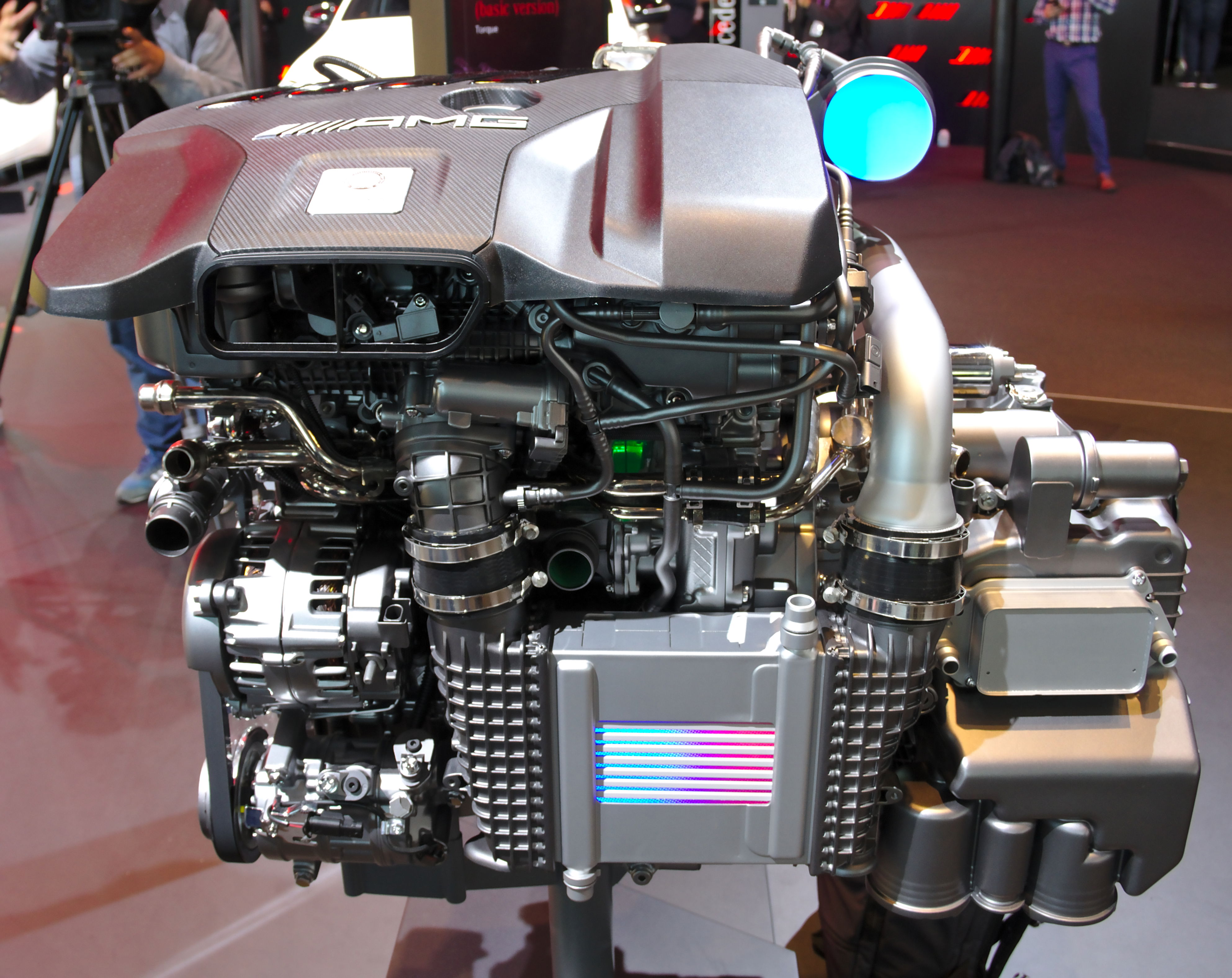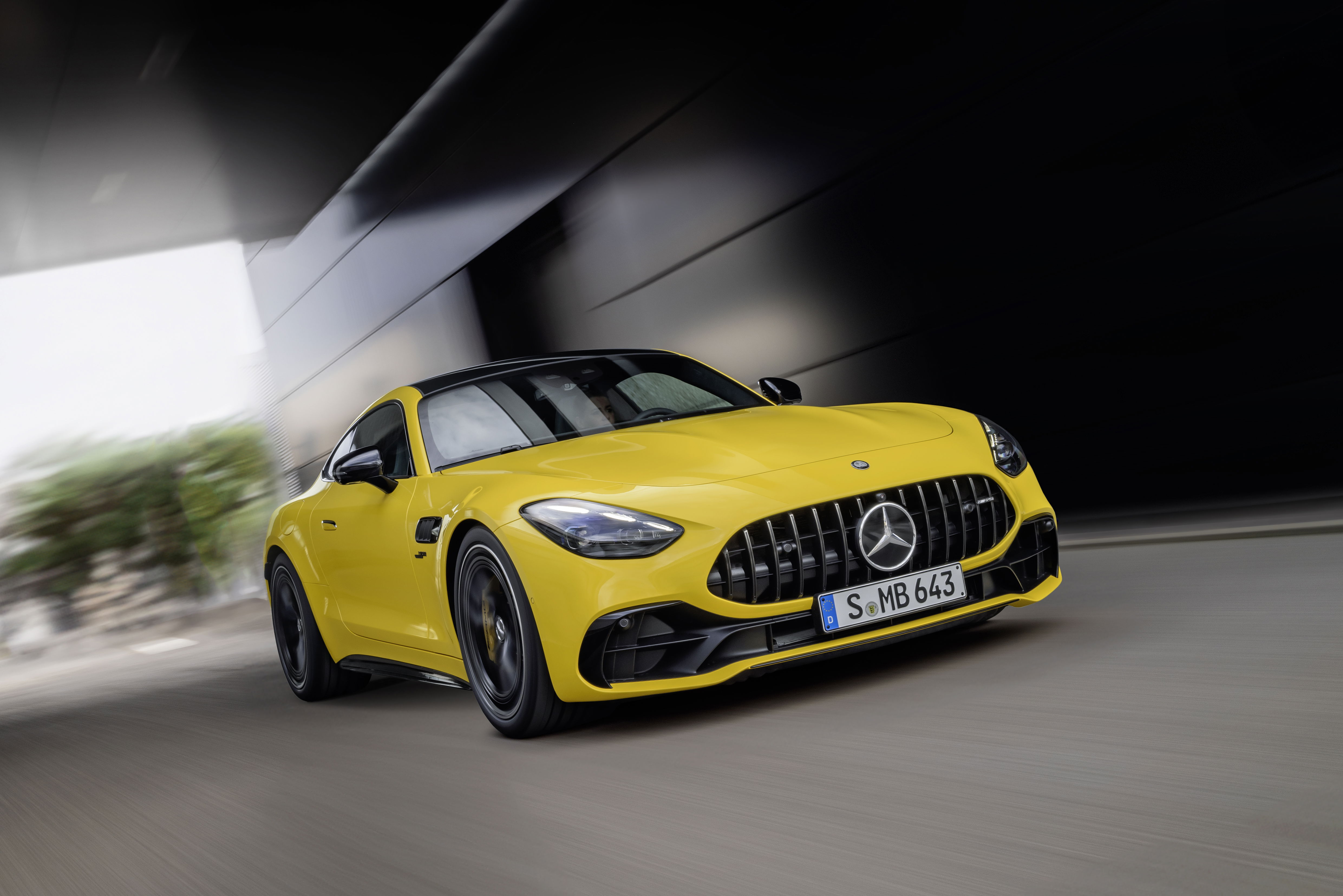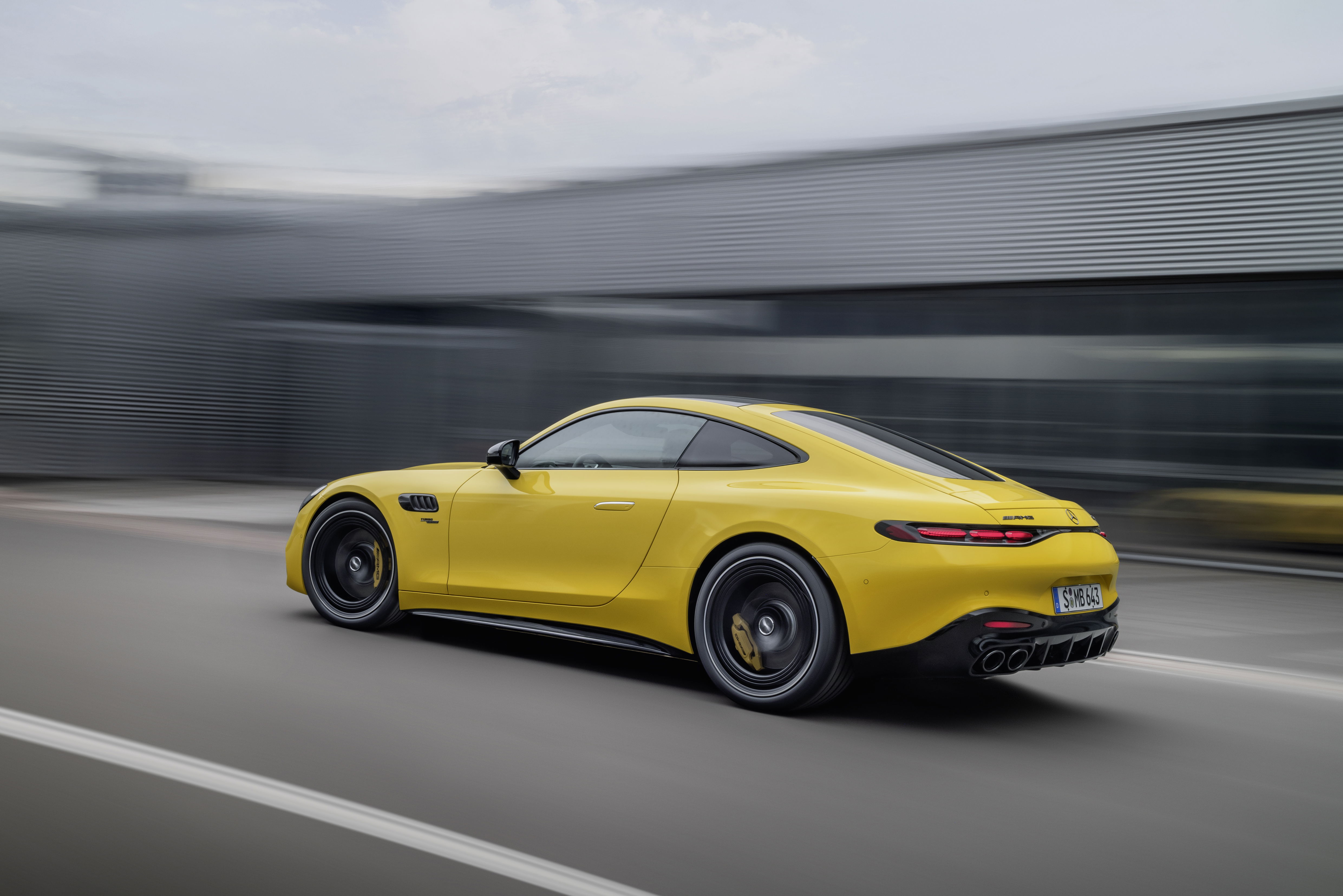The Highlights:
- The 2025 AMG GT 43 Coupe is powered by the famous 2.0-liter M139 4-cylinder engine
- The evolution of the M139 engine series since its debut in 2019
- Seven M139’s technical innovations, including roller bearings in the turbocharger and a closed-deck engine block
- The integrated electric turbocharger technology in select AMG models
The latest from Affalterbach is the new AMG GT 43 Coupe, powered by the phenomenal 2.0-liter M139 4-cylinder engine producing an incredible 416 horsepower. That’s 16 ponies more than Audi's glorious 2.5-liter TFSI inline-5 that propelled the RS3 to glory. The M139 is not new, having stunned the automotive world since 2019, but it remains unbeatable in the arena of high-performance 4-cylinders to date.
The GT Coupe series line of AMG sports cars isn't new either, having been around since 2014. The series includes various models like the GT, GT S, GT R, GT4, and Black Series, each with different performance levels and features. These cars epitomize high performance, technical excellence, and luxurious appeal. With this latest offering from the AMG GT family - the GT 43 Coupe, slated for 2025 - the automaker has promised an "elegant driving pleasure for purists."
Besides the car's active aerodynamics and in-house spring suspension with high-performance aluminum shocks, the GT 43 Coupe relies heavily on its storied M139 engine to deliver that elegant driving pleasure Mercedes speaks of. This M139 engine is the primary object of our fancy today.
What Is The M139 Engine?

Photo credit: Wikipedia
Born from the legacy of the M133 engine, this turbocharged inline-four masterpiece is the first AMG 4-cylinder engine to offer dual outputs. As is the custom at AMG, each M139 is made by hand on par with the division’s "one man, one engine" ethos. But the story doesn't end there.
A seamless fusion of port and direct fuel injection systems sees the M139 deliver a staggering 416 horsepower (310 kW) to become the world's most powerful four-cylinder engine in serial production.
Its specific output, an impressive 208 hp per liter or 104 hp per cylinder, solidifies this engine’s status as the king of 4-cylinders. Now crouching beneath the hood of the 2025 Mercedes-AMG GT 43 Coupe, let's find out how the M139 got and keeps its crown.
The Making Of The World's Most Powerful 4-Cylinder Engine

Since its inception in 2019, the M139 engine line by AMG has taken the world of high-performance 2.0-liter inline-4 engines by storm, surpassing the mighty Mercedes-AMG M133 series that previously held the title for the most robust production four-cylinder engine.
Unlike its forebear, which was offered in a single power configuration throughout its lifecycle, the M139 raised the bar with multiple power output options right from the get-go, starting with the standard model at 383 horsepower (285 kW) and an enhanced S version at 416 horsepower (310 kW).
The innovation didn't stop there; with the debut of the fifth-generation Mercedes-Benz C-Class (W206) and the seventh-generation SL-Class (R232) in 2022, Mercedes introduced a trio of new M139L variants (the 'L' signifying their longitudinal mounting), which boasted power outputs of 376 horsepower (280 kW), 403 horsepower (300 kW), and an earth-shaking 470 horsepower (350 kW).
In a market where 2.0-liter turbo fours have all but taken over, the M139 powerplants distinguish themselves by pushing the boundaries of performance. The base M139 eclipsed its predecessor, and the subsequent releases have continued to squeeze even more power from this compact engine block.
This engine’s power density is nothing short of remarkable, with the top-tier AMG models harnessing over 200 hp per liter, or 100 hp per cylinder — a figure that puts larger, more traditional sports car engines to shame. For example, the M139's S variant pumps out more power and torque than the revered 4.0-liter flat-6 powering the Porsche 718 Cayman GT4.
You could sing the M139’s song all day without overdoing it. For instance, the engine is largely responsible for the Mercedes-AMG A45 S’ title of the most powerful hot hatch on the market. Across the pond, the CLA45 S has become the most potent four-cylinder vehicle in the United States.
The excitement was, perhaps, the loudest when the C63 S E-Performance paired the M139L with a 201-hp electric motor, an uncanny marriage that outperformed six-cylinder icons like the BMW M3 and Alfa Romeo Giulia Quadrifoglio.
See also:
7 Best Features Of The Mercedes-AMG 63 S E PERFORMANCE – The Most Powerful SL Ever Made
A Deep Dive Into How The M139 Engine Works
The very idea of a 400-hp 4-cylinder engine felt like magic, which is probably why we have to remember that Mercedes had to look back to the magical yet very real M260 and its predecessor, the M133, to build the M139 engine.
These older engines lived as some of the most robust and refined compact engines in the company's lineup. However, in true AMG spirit, the engineers dialed up the intensity to deliver the M139's exceptional power.
At the renowned Affalterbach, the AMG team contrived at least seven technical and design innovations to extract every ounce of power from the turbocharged four-banger. First, perhaps, of these innovations is that AMG reoriented or flipped the engine 180 degrees along its vertical axis.
The novel layout moved the exhaust manifold to the back to let the engine sit lower in the chassis. This seemingly minor position adjustment dropped the car’s nose, which is really good for aerodynamics. The impact of this strategic engine positioning isn’t all about improving the aerodynamic profile.
The adjusted layout improved direct airflow to the engine, shortening the intake and exhaust paths and minimizing disruptions, which translates to a quicker and more responsive engine.
Secondly, the M139 is proudly the first Mercedes engine to integrate roller bearings within its turbocharger. These roller bearings, in contrast to the ball bearings used previously, reduce mechanical friction, allowing the turbo to achieve higher rotational speeds of up to 169,000 rpm swiftly.
The engine also features a twin-scroll turbocharger that utilizes dual scrolls operating in harmony to pressurize the compressor. This twin-scroll design is matched with a carefully arranged exhaust manifold that pairs cylinders to ensure continuous and non-interfering exhaust flow to the turbine, which enhances turbo responsiveness and bolsters low-end torque.
Thirdly, the M139 uses a closed-deck engine block to bolster structural integrity. Considering that the engine runs at a high boost pressure of 30.5 PSI, up from the 26.1 PSI in the M133, managing internal pressures is crucial.
The benefits of such a robust block are manifold, including the ability to endure cylinder pressures as high as 160 bar (2320.6 PSI) and support a maximum engine speed of 7200 rpm. A closed-deck block also means a sturdier area around the cylinders, with strategically placed openings for coolant and oil to flow through.
Fourthly, the M139’s designers expanded the exhaust valves to cope with the increased pressures. Of course, making room for the larger valves necessitated repositioning and angling the fuel injector in the cylinder head to accommodate the upsized valves.
The exhaust system also features variable CAMTRONIC valve control, which adjusts the valve opening durations based on the engine's load, optimizing comfort and fuel efficiency at lower loads and enhancing response and power at higher demands.
Fifthly, AMG introduced a dual-stage fuel injection system to fuel the M139's augmented power. In the first stage, piezo direct injectors spray fuel directly into the combustion chambers with precision at pressures up to 200 bar.
When additional fuel is required, the second stage activates solenoid port injectors in the intake manifold, supplying supplementary fuel at pressures reaching 6.7 bar, enabling the engine to reach its peak performance threshold.
Sixth, a crucial factor in the M139’s updated power is its friction-reducing technology, notably the NANOSLIDE cylinder liner coating that was carried over from its predecessors due to its exceptional effectiveness.
NANOSLIDE leverages a twin wire arc spray (TWAS) technique to apply a fine, durable, and porous coating to the cylinder walls. This innovative coating retains oil on the cylinder walls for longer periods, significantly lowering friction and wear, which is key to maintaining the engine's high performance and longevity.
Finally, the innovative electric exhaust gas turbocharger, borrowed straight from Formula 1 technology, is largely responsible for the M139’s dominance in the 4-cylinder pantheon. This system incorporates a compact yet powerful electric motor, approximately 1.6 inches thick, mounted onto the turbocharger's shaft.
By initializing the rotation of the compressor wheel even before exhaust gas pressure builds up, this electric motor mitigates turbo lag significantly. The result is a smoother and more immediate power surge, as the turbocharger can deliver boost virtually from idle, leading to increased agility and startlingly quick acceleration.
Take, for instance, the 2022 SL43 and 2023 C43 models, where the electric turbos are paired with a 48-volt onboard electrical system. The system could spin the turbo up to an astonishing 170,000 rpm in the SL43 and even higher, to 175,000 rpm in the C43.
This ensures a rapid response to throttle inputs across the entire rev range. Now, let’s see what the M139, with its electric turbos, is up to in the 2025 GT 43 Coupe.
10 Awesome 1-Seater Cars That Belongs In Every Enthusiast's Garage
The M139 And The 2025 Mercedes-AMG GT 43 Coupe

Since the beginning of this year, we've barely finished ohing and ahhing over an AMG new release before the next one interrupts and corners our attention.
We were barely done talking about the pricing details for the 2024 Mercedes-AMG GT 55 before the automaker dropped another bombshell– the new 2025 AMG GT 43 Coupe is raring to hit the market, cradling the famous M139 2.0-liter straight-4.
Granted, the GT 43 is the youngest of the family, not just by birth but also by output. However, boasting a RWD configuration supports the GT 43’s spirited performance despite a slightly longer 60mph sprint time than the AMG C 43 with which it shares this engine. The C 43 can wake to 60 mph in less than four seconds.
Despite its modest power output compared to its siblings, the GT43 compensates with clever features like a dynamic front louver system and an adjustable rear spoiler, all orchestrated by the sophisticated AMG SPEEDSHIFT® MCT 9G transmission.
By focusing on agility and performance, the GT43 proves that power isn't everything required to deliver elegant driving pleasure for purists.
Last Words On The AMG GT 43’s M139 4-Cylinder Engine

AMG's shift towards downsizing engines and incorporating hybrid technology might have disappointed some fans initially. However, the performance figures speak for themselves.
Mercedes-Benz has successfully engineered its four-cylinder engines to match, if not surpass, the power output of their V6 and V8 predecessors, all while maintaining a lightweight design.
Take, for instance, the M139L engine sitting pretty in the 2024 C63 S. It packs the same punch as the previous generation's 4.0-liter V8 biturbo, boasting an impressive 469 hp. This achievement is remarkable considering it's achieved with half the displacement, cylinders, and turbochargers.
Should we allow ourselves to forget that just decades ago, this level of power was reserved for the hefty V12 engines in the S-Class lineup?
So, regardless of one's opinion on engine downsizing, Mercedes-AMG's evolution with the M139 powerplants is undeniable. While the era of compact AMG vehicles roaring with V8s might be ending, 4-cylinder mills like the M139 represent the enduring presence of internal combustion engines, even if now electrified.